Over the last 80 years, formal training by a variety of schools has provided the skills and expertise the military services need to document and communicate the actions of the services. The consolidation of the Defense Information School and the Defense Visual Information School in fiscal 1996 and further consolidation with the Defense Photography School in fiscal 1998 created a single focal point in the Department of Defense for these specialties fields.
Advancements in information technology and recent base realignment and closure initiatives have contributed to the evolution of the school. The result is a single school proud of its historical roots and dedicated to serving the diverse requirements for public affairs, broadcasting and visual information.
Public Affairs Training

Prior to World War II, the armed forces' public affairs mission was accomplished mainly through the civilian press, but the lessons learned during the war years clearly indicated the need for a formalized public affairs training program in the military. If the military forces were to succeed in their vital mission of defending the nation, the active support of a well-informed public and an equally well-informed fighting force was a necessity. As a result, the Army Information School was established in January 1946 at Carlisle Barracks, Pa.
When the school began, public affairs was still in its infancy, radio was approaching its zenith, and television was an exciting curiosity. The newspaper was still the strongest voice for telling the armed forces story. Few precedents existed, even in civilian education, from which to teach the use of mass communication techniques in support of an external and internal information program that would apply both at home and abroad.
The Army Information School continued operating through 1947, with the Navy, Air Force and Marine Corps sending small numbers of students to the school for training. During this period, the Air Force operated a Public Information School at Craig Air Force Base, Ala., and the Navy established a journalism school at Great Lakes Naval Training Center, Ill.

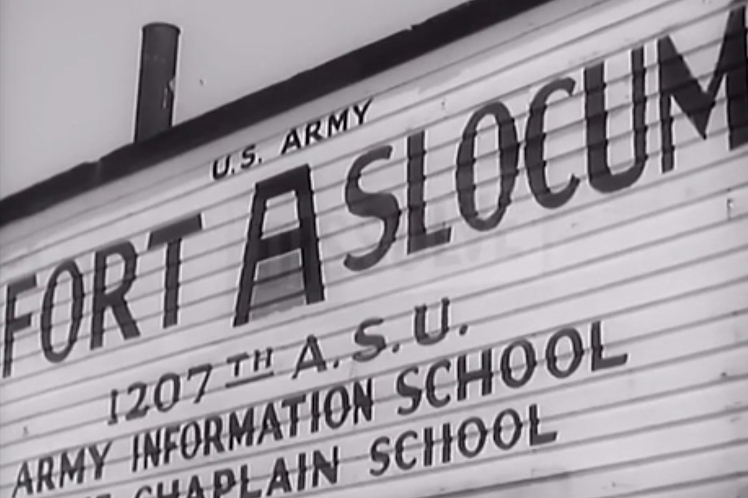
Early in 1948, a series of meetings with the Army Information School was held by representatives of each of the services to consider combining their separate information training efforts. Subsequently, the Armed Forces Information School was established. It was relocated to Fort Slocum, N.Y. in 1951, where larger and better-equipped facilities were provided. Although the Armed Forces Information School replaced the Army and Air Force's information schools, the Navy continued to operate its journalism school. Because individual services encountered difficulty in meeting their student quotas, the Armed Forces Information School reverted to an Army school again.
However, in 1961, a renewed effort began under the direction of the secretary of defense, Robert McNamara, and the assistant secretary of defense for public affairs, Arthur Sylvester, to consolidate service information training. Sylvester asserted that since public affairs training is common to all services and since principles of mass communication have universal application, combining the individual service schools into a joint-service school would be both economical and efficient. On Feb. 21, 1964, the Department of Defense issued a charter for the Defense Information School. In September 1965, DINFOS was moved to Fort Benjamin Harrison, Ind.
From 1964 to 1973, the Army exercised administrative control of the school through the deputy chief of staff for personnel, Department of the Army. In July 1973, the Army Training and Doctrine Command assumed responsibility for DINFOS, to relieve the general staff of day-to-day operational matters and to consolidate Army control of schools under a single command.
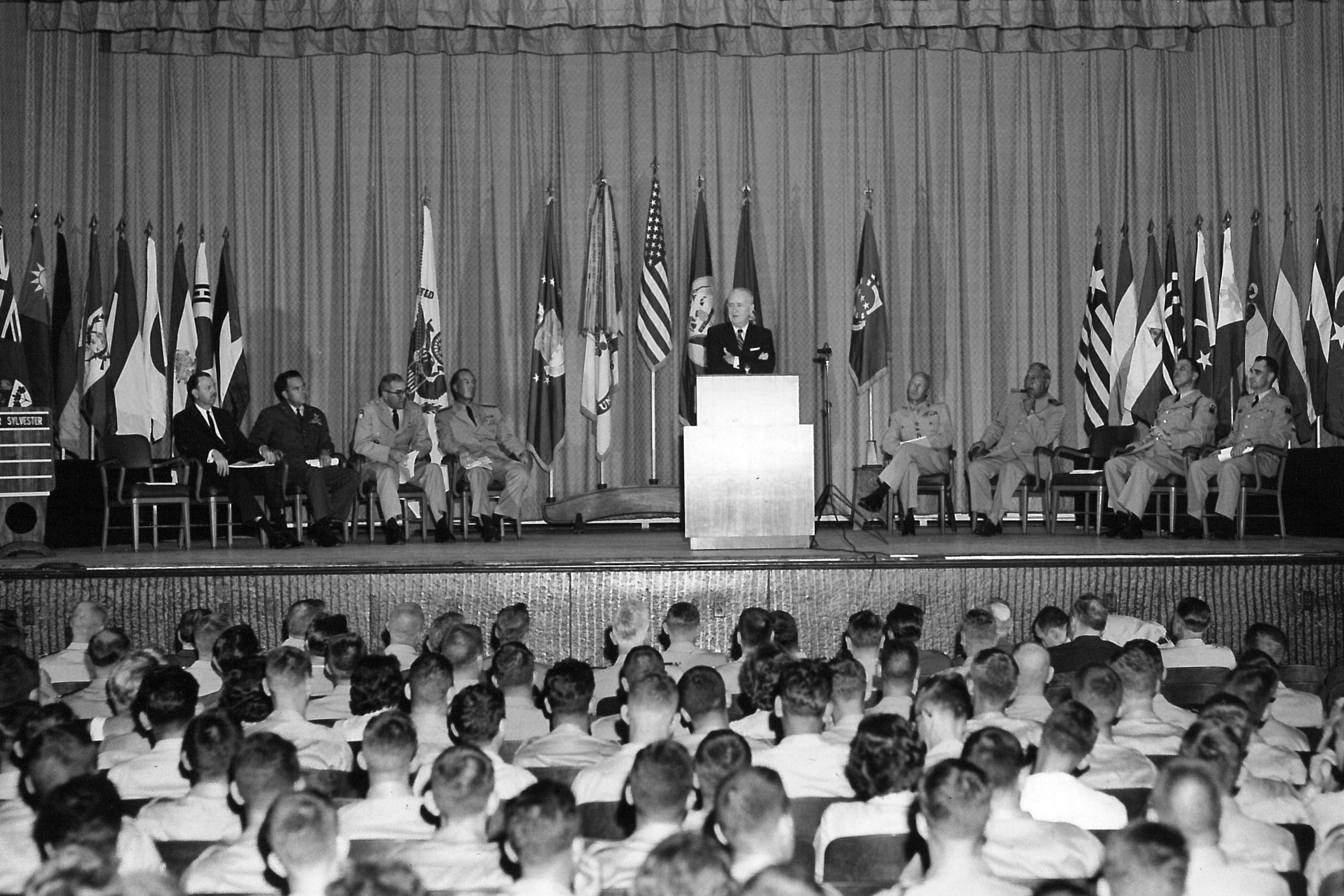
Arthur Sylvester, ASD-PA, in a ceremony marking the start of classes
in the new Defense Information School (July 27, 1964).
On July 28, 1992, the deputy secretary of defense approved the functional transfer and consolidation of service training for public affairs, visual information and broadcasting under the direction of the American Forces Information Service. The Defense Information School moved to Fort George G. Meade in 1995.
Army/Air Force Visual Information Training
The Army recognized the value of aerial photography during World War I and began training at Langley Field, Va. in 1917. The school moved to Chanute Field, Ill. in 1922; however, the problem of inadequate classroom and laboratory space resulted in the transfer of training to the newly established Lowry Field, Colo. On Feb. 12, 1938, a train brought the men and equipment of the photography department to Denver, and on Feb. 26, 1938, the Army activated the Denver branch of the Air Corps Technical School. Training began two days later.
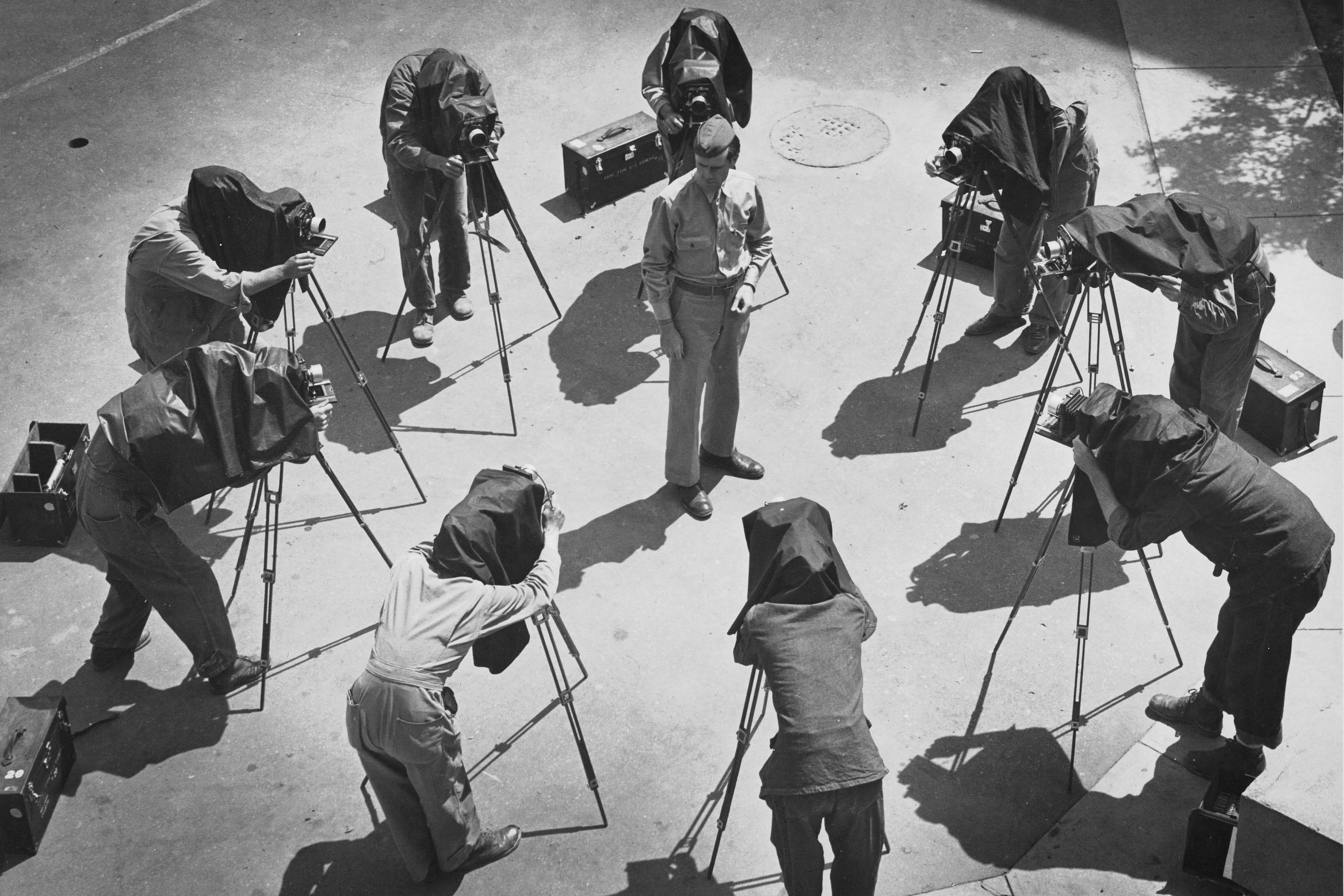
Lowry Field photo courtesy of the Wings Over the Rockies museum
Lowry Field was named for Lt. Francis Lowry, an aerial artillery and photographic observer. Lowry, who grew up in Denver, was shot down and killed on his 33rd photographic mission over France in World War I.
When the Department of Photography transferred to Lowry Field, it offered instruction in ground and aerial photography, mosaics (preparing a composite picture from overlapping photographs), mapping, cinematography, camera repair, and field equipment. This program expanded in the next few years as the United States strengthened its military forces in Europe and Asia in response to aggression by Germany and Japan.
On Oct.18, 1942, Lowry began a seven-day training week, with three daily shifts to meet the demand for trained specialists. On Jan. 28, 1943, the Women's Army Auxiliary Corps (redesigned the Women's Army Corps on Sept. 1, 1943) sent its first group to Lowry's photography school to become laboratory technicians. This was the first group of women trained at a military technical school.
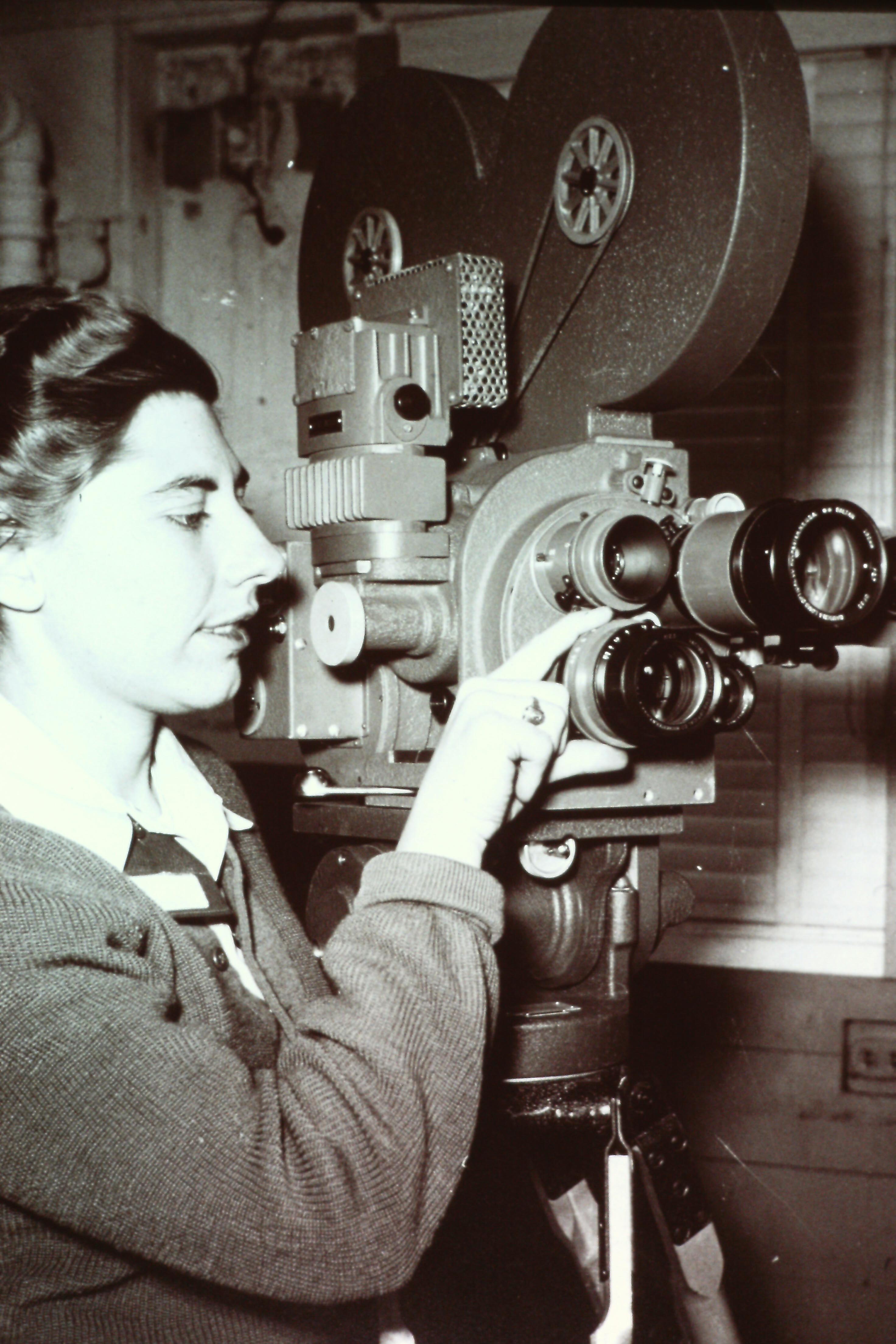
Lowry Field photo courtesy of the Wings Over the Rockies museum
In March 1944, Brig. Gen. Albert L. Sneed instituted a systematic war orientation program at Lowry to support the Army policy of having the world's best-trained, best-equipped and best-informed Army. The Army had six goals- to explain reason for fighting, to learn about the enemies, to know sides of other, to learn, to understand the news better, and finally, but maybe most important, "To give us faith in our country and its future."
One of the first students to train and graduate at Lowry Field was a Marine. The Marine Corps continued to send students to Lowry for training in various photography and graphics courses and for the production documentation (combat camera) apprentice course in 1975.
In 1977, the Army moved its television repair, still photography, motion picture photography, and audio and television production courses to Lowry Air Force Base from Fort Monmouth, N.J.
Draftsmen who were trained by the Army Engineering School, Fort Belvoir, Va. and who showed some skills as illustrators were used as graphic artists for many years. Although the Army established a separate specialty for illustrators, responsibility for training changed to the signal school in the early 1970s and was consolidated with Air Force training at Lowry Air Force Base in 1979.
Sailors received training in broadcast television systems maintenance and graphics at Lowry Air Force Base until the base closed in 1994.
In December 1992, the Defense Visual Information School was created from elements of the 3420th Technical Training Squadron and the Army 560th Signal Battalion at Lowry Air Force Base. DVISCH, under the direction of the American Forces Information Service, moved to Fort George G. Meade, Md. in 1994.
Navy Visual Information Training
The Navy recognized that with the advent of flight came the need for aerial photographers. In 1918, ship's cook Walter L. Richardson, a photography enthusiast, often captured aviation activities on film at Pensacola Naval Air Station, Fla. The Navy decided its photographers were a valuable tool for training and documenting aircraft testing, accidents and other aviation-related activities. Before long, the Navy made Richardson its first designated photographer. The Navy began to use photography in aerial reconnaissance during World War I, and Richardson was soon commissioned and charged with organizing the first Naval School of Photography at the Naval air station in Miami. As the war came to an end, so did the school.
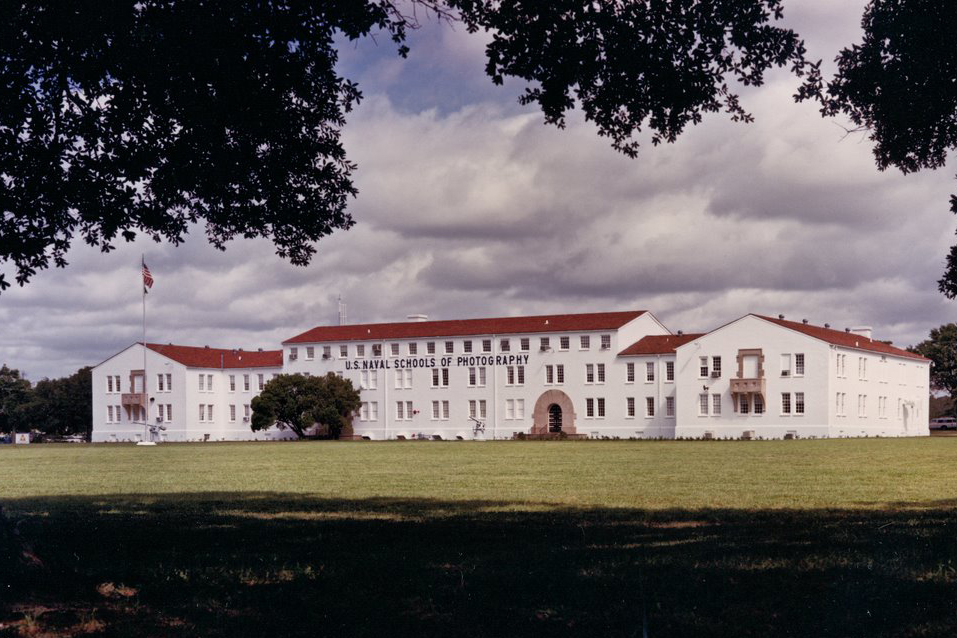
Navy Schools of Photography, NAS Pensacola
It reopened in 1920 at Naval Air Station Anacostia, near Washington, D.C. Because of limited facilities, the school at Anacostia was unable to keep up with growing fleet demands for trained photographers. In 1923, naval photography returned to its place of origin, Pensacola Naval Air Station.
On Dec. 1, 1944, the Naval Training School (Motion Picture Camera) began training at Pensacola, moving from the Photographic Science Laboratory, Anacostia. That same year the Navy directed that the Naval Training School (Camera Repair) move from Rochester, N.Y., to Pensacola NAS. An Army barracks, built in 1939, was renovated in 1950 to house the schools of naval photography.
As of Oct. 1, 1992, the Department of Defense consolidated all photographic training within the military, and the Naval Schools of Photography became the Defense Photography School, under the direction of AFIS.
Functional Transfer and Consolidation
In 1991, AFIS requested the Interservice Training Review Organization study the potential for consolidating the three schools providing public affairs, visual information and broadcast training into a single, joint facility. This study was completed in January 1992. It concluded that consolidation was both feasible and cost-effective.
On July 28, 1992, the deputy secretary of defense approved the functional transfer and consolidation of service training for public affairs, visual information and broadcasting into a single, joint-educational facility at Fort George G. Meade, Md. Effective in fiscal 1993, the Navy's School of Photography at Pensacola Naval Air Station and the visual information and broadcast elements of the Air Force 3420th Technical Training Group were transferred to AFIS, a DoD field activity under the assistant secretary of defense (public affairs). The Defense Information School was transferred to AFIS under the Program Budget Decision 752.
In November 1992, AFIS requested the Army Corps of Engineers audit the requirements for the consolidated school, including required personnel strengths, facility requirements, construction costs and other factors. Based on the finding of the audit, the decision was made to fund construction of the school. The Base Realignment and Closure program funded the movement of the Defense Visual Information School (Lowry) and the Defense Information School (Fort Benjamin Harrison).
On Nov. 1, 1993, the Defense Visual Information School advance party occupied temporary facilities at Fort George G. Meade establishing its presence and coordinating support for the shipment of equipment and personnel from Colorado. Training ended at Lowry Air Force Base with the graduation of the last classes on April 30, 1994, and on Aug. 9, 1994, the first class of the Basic Television Equipment Maintenance Course began in the temporary facilities on Fort Meade.
The move of training from Fort Benjamin Harrison began in April 1995, and the last Basic Journalist Course class graduated on the June 30, 1995. Three weeks later, on July 25, 1995, the first class of the Basic Journalist Course began training in the temporary facility. On Oct. 3, 1995, the Defense Information School and the Defense Visual Information School consolidated as the Defense Information School. On June 12, 1998, the Defense Photography School consolidated with the Defense Information School in a new facility on Fort George G. Meade, Md., completing the transfer and consolidation process.